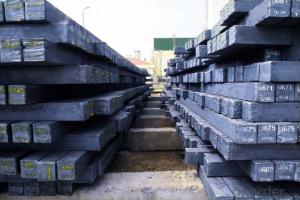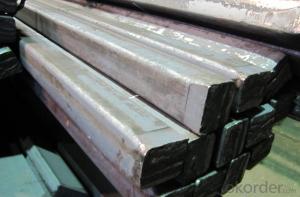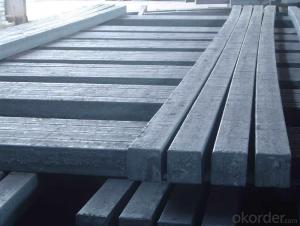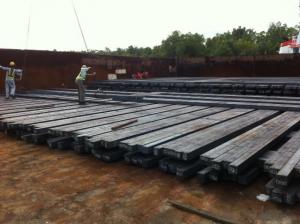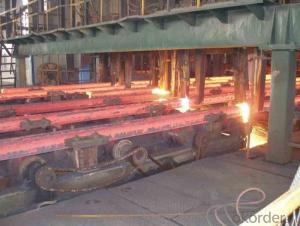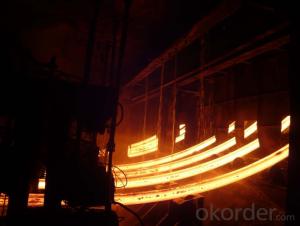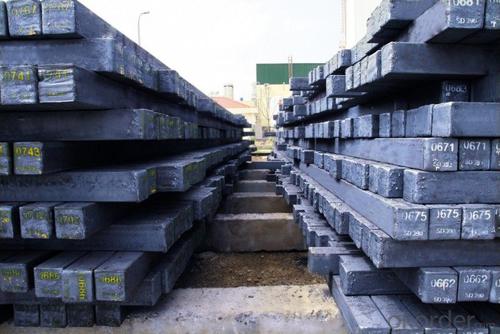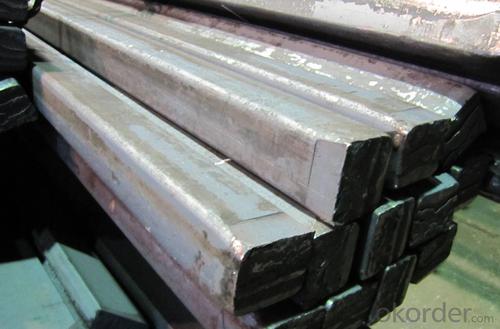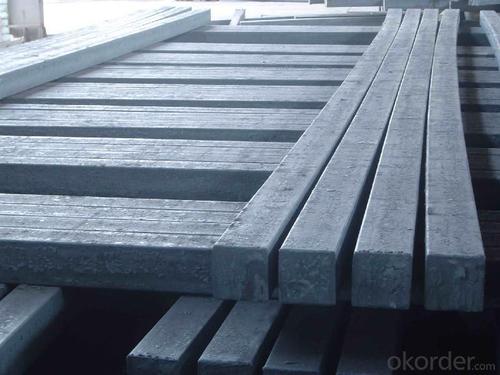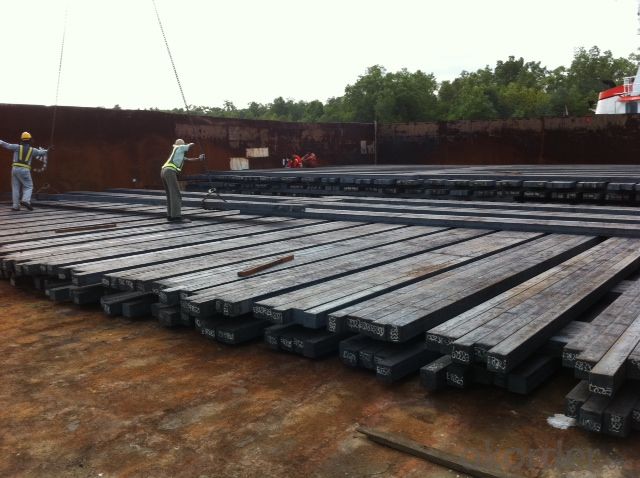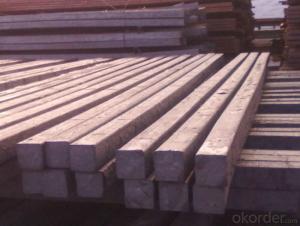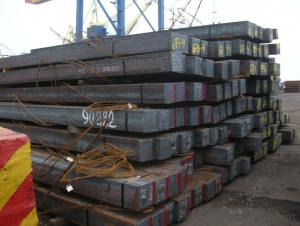Square Steel Billet Q235 3SP Grade Prime Quality 1#
- Loading Port:
- Tianjin
- Payment Terms:
- TT OR LC
- Min Order Qty:
- 2000 m.t
- Supply Capability:
- 50000 m.t/month
OKorder Service Pledge
OKorder Financial Service
You Might Also Like
Description of Square Steel Billet Q235 3SP Grade Prime Quality 1#
M. S. Billets are used for rolling of TMT Re-Bars of Fe415 and Fe500 Grade and various other structural steel products.
CRS Billets are used for rolling of CRS TMT Re-Bars.
Special Alloy Billets are used for rolling of any special grade TMT Re-Bars like Earthquake resistant TMT Re-Bars and for special grade structural steel products.
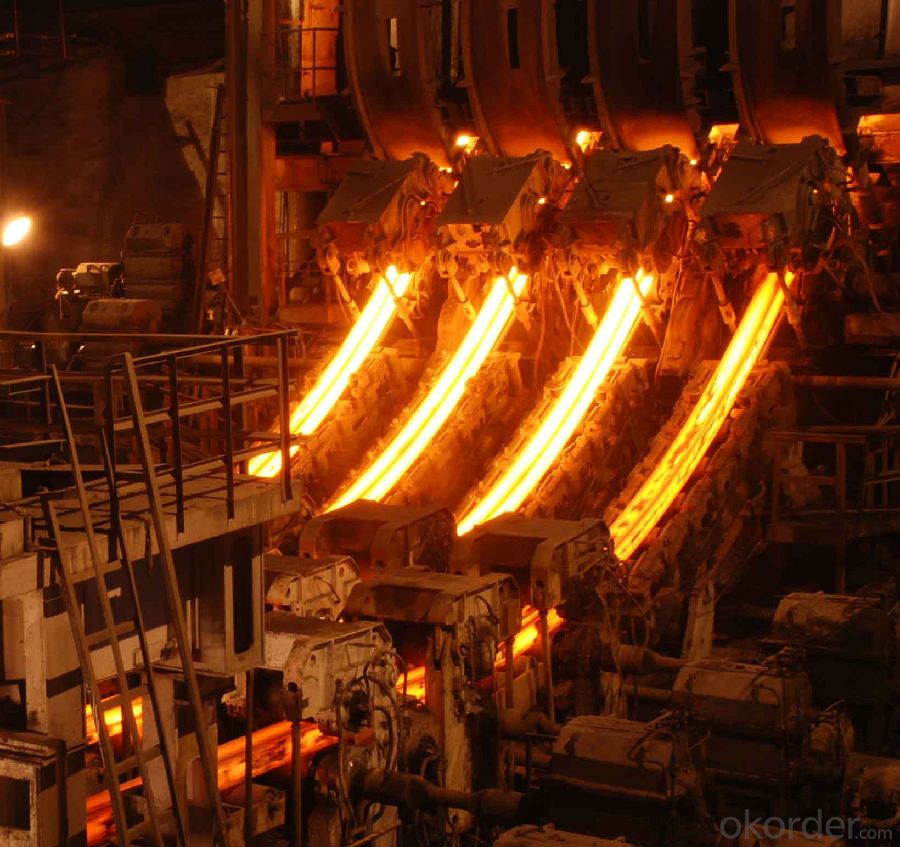
Main Feature Square Steel Billet Q235 3SP Grade Prime Quality 1#
Raw elements(C,Fe,Ni,Mn,Cr,Cu.)---Smelted ingots by AOD finery---hot rolled into black suface---pickling in acid liquid---cold drawn----polished by automatically machine--- cutting into pieces---checking quanlity
Applications of Square Steel Billet Q235 3SP Grade Prime Quality 1#
Widely Used in the areas such as Stainless Steel Fasteners, Chains, Kitchen and Sanitary wares, Furniture handles, Handrails, Electroplating and Electrolyzing pendants, Foods, Electron, Petroleum, Construction and Decoration, etc. Products have a high strength after cold-working. Electronic products parts, Medical appliance, Springs, Bus Inside and Outside packaging and building, Street Lamp Posts, etc. Decoration materials and Outdoor Publicity Billboard. Used for the products which have the Anti-Stress Corrosion requirement. Electron Products, Table-wares, Bolts, Nuts, Screen Meshes, Cumbustors and so on.
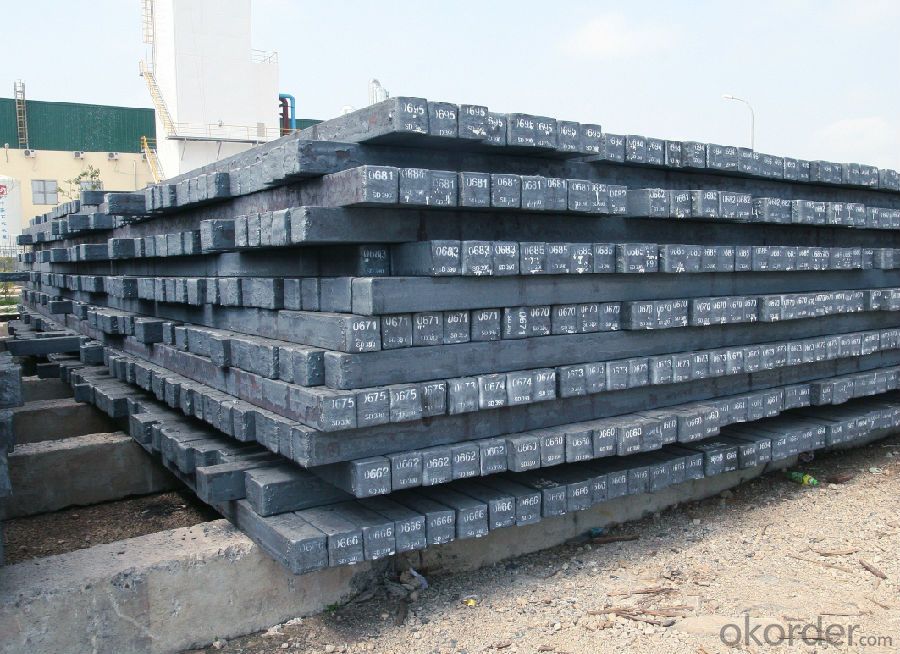
Specifications of Square Steel Billet Q235 3SP Grade Prime Quality 1#
| Standard | C(%) | Mn(%) | S(%) | P(%) | Si(%) |
| Q195 | ≤0.12 | ≤0.50 | ≤0.040 | ≤0.035 | ≤0.30 |
| Q235 | ≤0.20 | ≤1.40 | ≤0.045 | ≤0.045 | ≤0.35 |
| Q275 | ≤0.22 | ≤1.50 | ≤0.045 | ≤0.045 | ≤0.35 |
| 20MnSi | 0.17-0.25 | 1.2-1.6 | ≤ 0.050 | ≤ 0.050 | 0.40-0.80 |
| 3SP | 0.14-0.22 | 0.40-0.85 | ≤ 0.050 | ≤ 0.040 | 0.05-0.15 |
| 5SP | 0.28-0.37 | 0.50-1.00 | ≤ 0.050 | ≤ 0.040 | 0.15-0.30 |
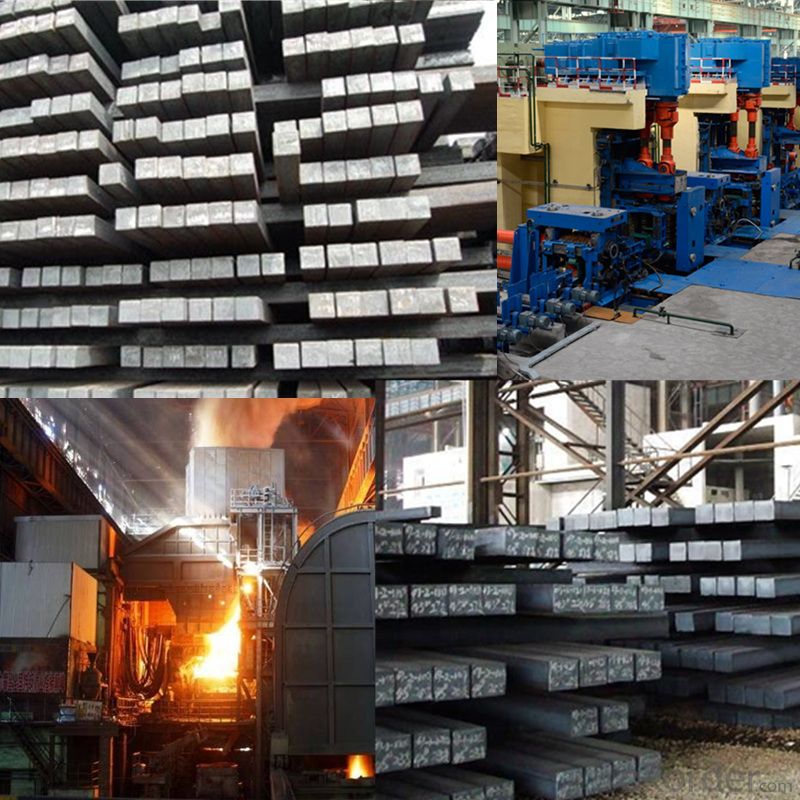
FAQ of Square Steel Billet Q235 3SP Grade Prime Quality 1#
We have organized several common questions for our clients,may help you sincerely:
1. How Can I Visit There?
Our company is located in Tianjin City, China, near Beijing. You can fly to Tianjin Airport Directly. All our clients, from home or aboard, are warmly welcome to visit us!
2. How Can I Get Some Sample?
We are honored to offer you sample.
3. Why choose CNBM?
Our delivery time about 15-20days for standard sizes, if you have other requirements like hardness, quanity and width ,it is about 20-40days. But don't worry we also try our best for the delivery time ,because time longer and our cost is higher.
- Q: Can steel billets be used in the production of medical equipment?
- Yes, steel billets can be used in the production of medical equipment. Steel is known for its strength, durability, and resistance to corrosion, making it an ideal material for manufacturing various medical devices. Steel billets, which are the initial semi-finished product of steel production, can be further processed and shaped into specific components or parts required for medical equipment. These components can include surgical instruments, implants, orthopedic devices, needles, and other medical tools. Steel's mechanical properties and ability to withstand sterilization processes make it a suitable choice for producing safe and reliable medical equipment.
- Q: How are steel billets measured?
- Steel billets are typically measured using various instruments such as calipers, micrometers, or laser measurement systems to accurately determine their dimensions, including length, width, and height. These measurements are crucial for ensuring quality control and meeting specific industry standards.
- Q: Are steel billets used in the shipbuilding industry?
- Yes, steel billets are commonly used in the shipbuilding industry. Steel billets are semi-finished steel products that are further processed into various shapes and sizes to construct different components of a ship's structure, such as hulls, decks, and bulkheads. These billets provide the necessary strength and durability required for the construction of ships, making them an essential material in the shipbuilding process.
- Q: What is the global production capacity of steel billets?
- The global production capacity of steel billets is difficult to estimate accurately as it varies from year to year and is influenced by factors such as market demand, economic conditions, and technological advancements. However, according to the World Steel Association, the total global production capacity for steel billets was approximately 1.86 billion metric tons in 2019. This capacity is spread across various countries and steel-producing regions, with China being the largest producer followed by India, Japan, and the United States. It is important to note that these figures are subject to change as the steel industry continues to evolve and expand.
- Q: Can steel billets be used in the production of automotive components?
- Yes, steel billets can be used in the production of automotive components. Steel billets are semi-finished steel products that are typically used to produce various types of steel products, including automotive components. They can be further processed through rolling, forging, or other manipulation techniques to form the desired shape and size of the automotive component. Steel is a preferred material for automotive components due to its high strength, durability, and ability to withstand harsh operating conditions. Moreover, the use of steel billets allows for flexibility in manufacturing, as they can be tailored to meet specific design requirements and performance specifications of different automotive components.
- Q: What are the main factors affecting the dimensional stability of steel billets?
- There are several main factors that can affect the dimensional stability of steel billets. 1. Temperature: One of the most significant factors is temperature. Steel billets can undergo thermal expansion or contraction depending on the temperature they are exposed to. Changes in temperature can cause the billets to expand or contract, leading to dimensional changes. It is crucial to control the temperature during the manufacturing process and subsequent cooling stages to minimize these effects. 2. Cooling rate: The rate at which the steel billets cool down after being heated also affects their dimensional stability. Rapid cooling can result in internal stresses within the billet, causing it to warp or distort. On the other hand, slow cooling can lead to uneven cooling and uneven dimensional changes. 3. Composition: The chemical composition of the steel billets plays a significant role in their dimensional stability. Different alloying elements, impurities, and carbon content can influence the material's behavior during heating and cooling. For instance, higher carbon content can increase the likelihood of warping or distortion. 4. Mechanical stresses: Mechanical stresses from handling, transportation, or machining processes can impact the dimensional stability of steel billets. Excessive bending, twisting, or pressure can cause permanent deformation or residual stresses within the billet, affecting its overall dimensional stability. 5. Heat treatment: The heat treatment process can also influence the dimensional stability of steel billets. Different heat treatment methods, such as annealing, quenching, or tempering, can introduce internal stresses or phase transformations that may alter the billet's dimensions. 6. Manufacturing techniques: The processes used during the production of steel billets, such as casting, rolling, or forging, can have an impact on their dimensional stability. Inadequate control or inconsistencies in these manufacturing techniques can lead to variations in the billet's dimensions. It is crucial to consider and control these factors to ensure the dimensional stability of steel billets, as any dimensional changes can affect the subsequent processing steps and the final product's quality.
- Q: What are the different types of steel used in manufacturing steel billets?
- Steel billets are manufactured using various types of steel, including carbon steel, stainless steel, alloy steel, and tool steel. 1. Carbon Steel: The most commonly used steel for manufacturing steel billets is carbon steel. It contains a small percentage of carbon (typically 0.05% to 0.25%), which provides it with strength and durability. Carbon steel is versatile and can be used in a wide range of applications. 2. Stainless Steel: Stainless steel is highly regarded for its corrosion resistance and high strength. It contains chromium, which forms a protective oxide layer on the surface, preventing rust and corrosion. Stainless steel is commonly used in applications where resistance to moisture and chemicals is necessary, such as in the construction of bridges and buildings. 3. Alloy Steel: Alloy steel is created by adding different alloying elements to carbon steel, including manganese, nickel, chromium, and molybdenum. These elements enhance the steel's properties, such as its strength, hardness, and resistance to wear and tear. The automotive and aerospace industries frequently employ alloy steel. 4. Tool Steel: Tool steel is specifically designed to possess high hardness, resistance to abrasion, and the ability to withstand high temperatures. It is frequently utilized in the production of cutting tools, molds, and dies. Tool steel typically comprises a combination of alloying elements, such as tungsten, vanadium, and cobalt. These examples represent a few of the diverse types of steel employed in the manufacturing of steel billets. The selection of the specific steel type relies on the desired properties and intended application of the steel billets.
- Q: What are the different surface treatments applied to steel billets?
- There are several different surface treatments that can be applied to steel billets, depending on the desired end result and application. Some of the common surface treatments for steel billets include: 1. Shot Blasting: This process involves propelling small metal or mineral particles at high speed onto the surface of the steel billets. Shot blasting helps to remove any surface impurities, such as rust or scale, resulting in a clean and uniform surface. 2. Pickling: Pickling is a chemical treatment that involves immersing the steel billets in an acid solution, typically hydrochloric or sulfuric acid. This process helps to remove any oxide layers or scale from the surface of the billets, resulting in a clean and smooth surface. 3. Phosphating: Phosphating is a chemical conversion coating process that involves immersing the steel billets in a solution containing phosphate salts. This treatment helps to create a thin, adherent, and corrosion-resistant phosphate film on the surface of the billets. 4. Galvanizing: Galvanizing is a popular surface treatment for steel billets that involves coating them with a layer of zinc. This process helps to provide excellent corrosion protection and enhances the overall durability of the steel billets. 5. Painting: Painting is another common surface treatment for steel billets, where a layer of paint is applied to the surface. This can provide both aesthetic appeal and additional protection against corrosion. 6. Electroplating: Electroplating is a process where a thin layer of metal, such as chromium or nickel, is deposited onto the surface of the steel billets using an electrical current. This treatment can enhance the appearance, corrosion resistance, and wear resistance of the steel billets. It is important to note that the choice of surface treatment for steel billets depends on various factors, including the intended use, environmental conditions, and cost considerations. Each treatment offers specific advantages and it is crucial to select the most suitable option to ensure optimal performance and longevity of the steel billets.
- Q: What are the potential applications of steel billets in the defense sector?
- Due to their strength, durability, and versatility, steel billets have numerous potential applications in the defense sector. Here are several examples: 1. Armored Vehicles: Steel billets can be utilized to manufacture the hulls and components of armored vehicles, offering improved protection against ballistic threats and explosive devices. Their high strength and toughness make them suitable for enduring extreme conditions and impacts on the battlefield. 2. Weapon Systems: Steel billets can be incorporated into the production of various weapon systems, such as artillery guns, tanks, and missile launchers. These components require materials capable of withstanding high pressures, heat, and mechanical stresses, all of which steel billets can provide. 3. Defense Infrastructure: Steel billets can be employed in the construction of defense infrastructure, including military bases, bunkers, and fortifications. Their high strength and resistance to corrosion make them suitable for enduring environmental and physical challenges. 4. Naval Applications: Steel billets are crucial in the manufacturing of naval vessels, such as submarines, destroyers, and aircraft carriers. The ability of steel billets to withstand the harsh conditions of the marine environment, including corrosion and pressure, makes them an ideal choice for constructing these vessels. 5. Personal Protective Equipment (PPE): Steel billets can be used to produce body armor, helmets, and other protective gear for military personnel. The exceptional strength and impact resistance of steel billets offer enhanced protection against bullets, shrapnel, and other potential threats on the battlefield. 6. Military Infrastructure: Steel billets can be utilized in the construction of bridges, runways, and other critical military infrastructure. Their high load-bearing capacity and durability ensure the longevity and reliability of these structures, thereby supporting military operations. Overall, steel billets have diverse and crucial potential applications in the defense sector. Their properties make them an invaluable material for various defense applications, ensuring the protection of personnel, equipment, and infrastructure in challenging operational environments.
- Q: How are steel billets used in the automotive industry?
- The automotive industry heavily relies on steel billets, which are indispensable due to their strength, durability, and versatility. These billets are extensively used to manufacture a wide range of automobile parts, including chassis, engine components, suspension systems, and body panels. Among the many applications of steel billets in the automotive industry, crankshafts stand out as a prime example. Crankshafts play a vital role in converting the reciprocating motion of pistons into rotational motion, and they must endure immense stress and pressure. Steel billets possess the necessary strength and resilience to meet these demanding requirements. Similarly, steel billets find application in the production of camshafts, which control the operation of an engine's valves. Camshafts must exhibit high precision and durability to withstand continuous mechanical stresses, and steel billets offer the mechanical properties required for reliability. Furthermore, steel billets are commonly employed in manufacturing various suspension components like control arms and axle shafts. These components must withstand heavy loads and shocks while maintaining their structural integrity, making steel billets an ideal material choice. In addition, steel billets are utilized in the manufacturing of body panels, including doors, hoods, and fenders. These parts necessitate high strength to ensure passenger safety and withstand impacts, and steel billets provide the required strength while also being cost-effective. Moreover, transmission components such as gears and shafts are also produced using steel billets. These parts demand high strength, wear resistance, and dimensional accuracy, all of which are provided by steel billets. In summary, steel billets play a vital role in the automotive industry by enabling the production of various components and parts that require exceptional strength, durability, and precision.
Send your message to us
Square Steel Billet Q235 3SP Grade Prime Quality 1#
- Loading Port:
- Tianjin
- Payment Terms:
- TT OR LC
- Min Order Qty:
- 2000 m.t
- Supply Capability:
- 50000 m.t/month
OKorder Service Pledge
OKorder Financial Service
Similar products
Hot products
Hot Searches
Related keywords
